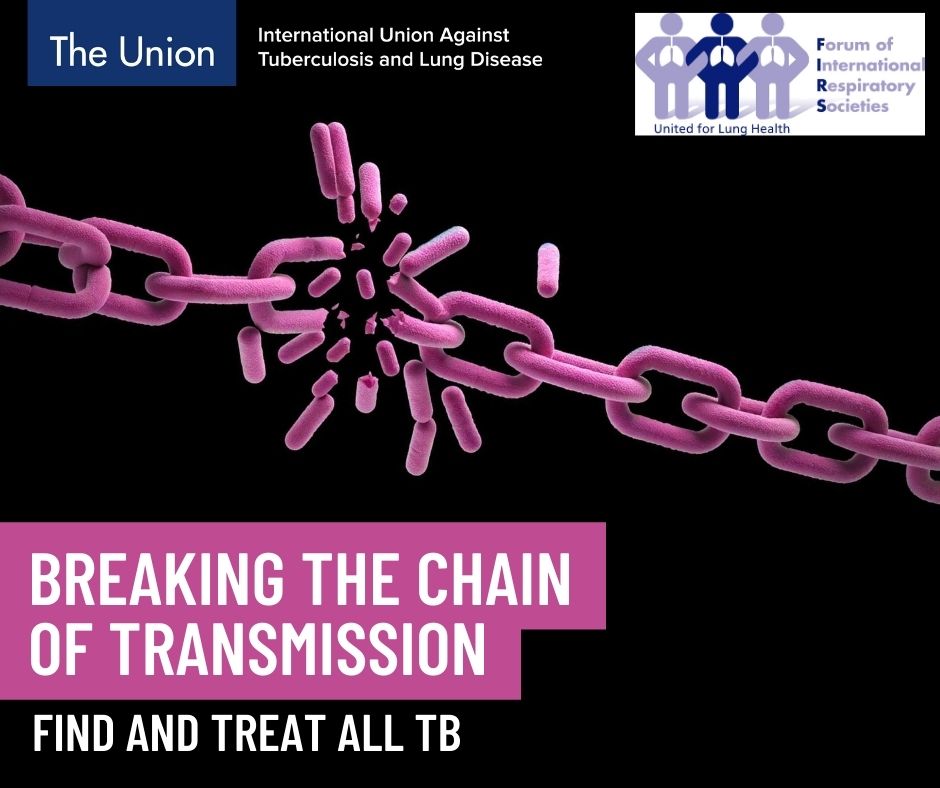24 March, 2024
Break the chain of transmission to end tuberculosis – World TB Day 2024
Respiratory groups call for comprehensive TB screening in high-burden settings.
On World TB Day, 24 March 2024, the Forum of International Respiratory Societies (FIRS), of which the European Respiratory Society (ERS) is a founding member, calls on all stakeholders, including multilateral agencies, governments, national and local programmes, non-governmental organisations, academics, activists and donors to focus on activities that will break the chain of transmission in high-burden settings in order to end tuberculosis (TB).
In high-burden settings, TB is endemic: meaning everyone is at risk, all the time, through the unbroken chain of transmission. To break the chain, it is critical that we screen everyone in high-burden settings for TB, so that we can find and treat all people with TB and prevent them from infecting others. The latest evidence shows that in high-burden settings, most people with infectious TB do not have symptoms (such as, cough or fever) and many are not members of high-risk groups. Hence, it is vital that screening for TB is not limited to those with symptoms or those who are members of high-risk groups.
During the height of the COVID-19 pandemic, before the availability of vaccines, this approach of widespread testing, was rolled out by governments across the globe and proved to be highly effective in controlling the spread of COVID-19.
Professor Guy Marks, President and Interim Executive Director of the International Union Against Tuberculosis and Lung Disease (The Union), a member of FIRS, says: “We must be brave and recognise that the current strategy to end TB in high-burden countries is not achieving the results we hoped for. We need to change our approach if we are to win the fight against this infectious disease.”
In 2022, 10.6 million people fell ill with TB and 1.3 million died from the disease – more deaths than from any other infectious disease.
Professor Marks explains:
“The incidence of TB in high-burden countries is falling at a glacially slow pace. The simple reason for this is that far too many people with TB remain undiagnosed and untreated, often because they do not experience or recognise symptoms that lead to a diagnosis. These people are infectious and can transmit the infection to others in their households, workplaces and communities. So, the transmission continues: more people are infected and many of them develop TB.”
It was the same with COVID-19, another airborne infection, where much of the spread in the community occurred from people with infectious COVID-19 who did not have symptoms.
Professor Marks adds: “The latest evidence suggests that in high-burden settings, most people with TB have been recently infected (within the last two years). This means that reducing the rate of new infections (or reinfections) with TB can have a big impact on preventing people from becoming sick with TB, and hence, breaking the chain of transmission and ending TB.”
The standard approach to controlling TB has been to wait for people to seek care, be correctly diagnosed and take medication. However, we now know that many people with infectious TB do not have symptoms, and as a result, do not visit healthcare facilities seeking care.
Additionally, those who do seek care often encounter hurdles in terms of accessing diagnosis and treatment, due to TB not being appropriately prioritised by healthcare systems.
Professor Marks concludes: “These strategic and operational modifications will not achieve an end to TB in isolation. They must be accompanied by a change in public mindset and behaviour towards TB.”





